The Klikk Camera Stand
By MIKE PASINI
Editor
The Imaging Resource Digital Photography Newsletter
Review Date: November 2007
If Dr. Phil devoted a show to photographers, the topic of tripods would elicit some disturbing confessions. Everyone knows you need one. Everyone knows why. But very, very few of us are emotionally stable enough to actually carry one around.
If he wanted to broadcast a week-long series on this phenomenon, he could. Because there are dozens of ways photographers have tried to substitute some gadget for a tripod. None of them actually replace a tripod, but they are all useful in some situations. Like lies.
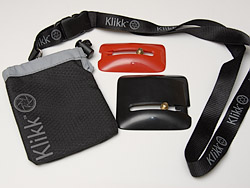
Klikk. The case and strap come with either a small or large Klikk in either red or black.
The bean bag is a common favorite, providing an accommodating support on irregular surfaces. The Joby Gorillapod (http://www.joby.com/products/gorillapod/original/) is another, wrapping its three legs around nearly anything to do the same. We're devoted to the Clampette (http://www.highsierramfg.com), a little C-clamp with a tripod screw on it. And we always carry a string with a quarter-inch/20-thread bolt to make a counter-force support in a pinch.
No doubt you have your favorite, too. And if we were on Dr. Phil's show right now, we'd all be laughing about it. Nervously.
That's because we feel guilty about it. We don't have that Pavarottian who-me smile that can get away with anything short of murder.
ENTER KLIKK | Back to Contents
Well, we don't have Pavarotti anymore, but we do have Klikk, whose corporate slogan is "Just Smile!"
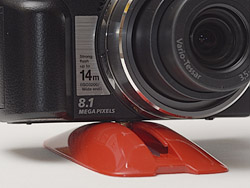
Mounted. A small Klikk supports a centered tripod mount only 12mm off the ground.
Klikk, also made in Italy, is a camera base. That's all. Just an ABS plastic stand with a special brass tripod screw designed to slide along a long slot so you can aim the camera up or down, right or left. Very light, very small, it's just 12mm tall.
The Klikk includes a padded case with a neck strap and metal hock. The 4.5x3.75-inch case is large enough to include an ultra-compact camera with the Klikk positioned over the LCD, providing a measure of protection, too. But it's small enough it probably fits in your current camera case, too.
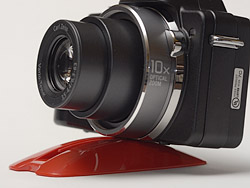
Side View. We've pointed the H3 up.
We have a friend who has cracked the LCD on every Canon digicam he's owned (quite a few now). He always carries his camera in his coat pocket. This little investment could save him hundreds of dollars a year.
And, ingeniously, it comes in two configurations, a small 2.0x3.25-inch model and a 3.25x3.25-inch version. The smaller one is just right for cameras whose tripod socket is in the middle of the camera. And the larger one is just right for the majority of cameras that have a tripod socket well off-center.
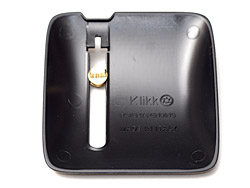
Underneath. Hollowed out, the Klikk can accommodate uneven surfaces, too.
You have to be Italian to find this funny, but you also get your choice of color. Either size can be ordered in red or black. Or, as the poet Montale, put it, "chierico rosso, o nero." A reference to the sacred and the profane. He, too, come to think of it, could get away with anything short of murder.
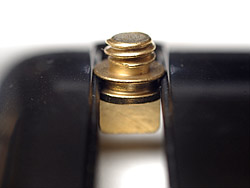
Special Screw. It slides in the guide but stays firmly attached to your camera.
The bottom of the base is not flat, so you can actually make a three-point, tripod-like contact between the base and an uneven surface. We found it easy to angle up or down, although the larger side is easier for sideways adjustments. Just make sure the plastic base doesn't slip from any precarious perch you place it on.
So that's it. A plastic base, slightly bowed, with a slot in it for a small brass tripod screw.
PERFORMANCE | Back to Contents
Attaching the Klikk is simple. Just aim the brass screw at your tripod socket and twirl. The plastic guide runner has a good grip on the brass screw, but doesn't grip the brass screw tight enough to twist it the final hand-tightened quarter turn or so. Just finish off by twisting the screw from the bottom until you've got a nice tight connection. Thanks to the special design of the screw, you aren't binding the screw to the base when you tighten it to the camera.
Then decide if you want your camera to point up, down or straight ahead. To set or change the angle, just slide your camera along the guide runner until it's set the way you want it.

Unusual Angle. We sat it next to our secretary, busy typing up this review.
One of the advantages of using a flat camera support like this is the unusual angle you can shoot from. You can set it on a table or desk to get an intimate view in Macro mode of what's happening. Or you can set it on the floor for an interesting look up at things. Prop the Klikk's front edge on something to raise the angle of view, if you like. Just make sure you have three points of support.
We tested a few angles, shooting our fingers flying over the keyboard and our feet flat on the ground. Even a shot up at our face frowning in concentration as we wrote this review. It was actually kind of fun.

Casual Friday. The Klikk was propped up on a paper weight to catch this devotion to duty.
We set Macro mode on a Sony H3 here for review and turned on the self-timer. Then we set the camera at a flattering angle and forgot about it. Ten seconds later, we had an unusual shot.
You don't have to use the self-timer, though. You can just use the base like you would any support.
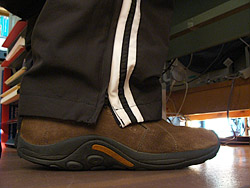
Down, Not Out. Flat on the floor, the Klikk sees things you usually can't.
You don't even have to be shooting to find it useful, we found. Mounting the camera on the Klikk makes it easier to connect a USB cable and transfer files to your computer if your USB connection is not on the base of the camera. Often we find we have to lay a camera down on its LCD or faceplate to transfer images. Ultracompacts are pretty unstable as soon as you connect a cable to them. But the Klikk stabilizes the camera so we can make the connection, power on the camera and transfer our photos without worrying about scratching the LCD or nicking the front of the camera.
And you don't have to use an ultracompact camera, either. We attached the Klikk to a Canon Rebel XTi and it didn't crack. It did wobble a bit as the ABS plastic flexed, but we were able to press the Shutter button and get a sharp shot without resorting to the self-timer. You don't get the full range of movement (the camera's center of gravity can easily be shifted beyond the base), but you do get support for a straight-ahead or upward angle.
PHILOSOPHICAL QUESTIONS | Back to Contents
How does it improve on all those other gadgets (or even just laying the camera flat on its bottom)?
It beats a bean bag because it's a lot smaller and lighter (not to mention flat). It beats the Clampette because it's a lot simpler (you don't have to find something to clamp to). It beats the Gorillapad because it's shorter. You can't get any lower angle than this.
After a great deal of thought on the matter, we believe the keys to its usefulness are the little hump and the hollow bottom. The hump gives you a way to angle the camera a full 18 degrees either up/down or left/right, depending how you mount the camera. And the hollow bottom lets you deal with uneven surfaces (including something to prop up on end).
For a long time, we've been addicted to this genre of gadget. It's a healthy addiction. You come home with sharp shots. But we have to say we've never used a tripod substitute this unobtrusive and yet this useful.
It will set you back 15 euros or roughly $22, including taxes and airmail shipping (which only took a day from Milan to San Francisco). To order directly from the company, visit http://www.klikk.it and click the English button. Check out the animated demos, too.
If you need convincing, make a gift of one to someone and watch how much they rave about it. As tripods go, it's the least pain with the most gain yet. You may not be able to get away with anything short of murder, but you will "just smile."